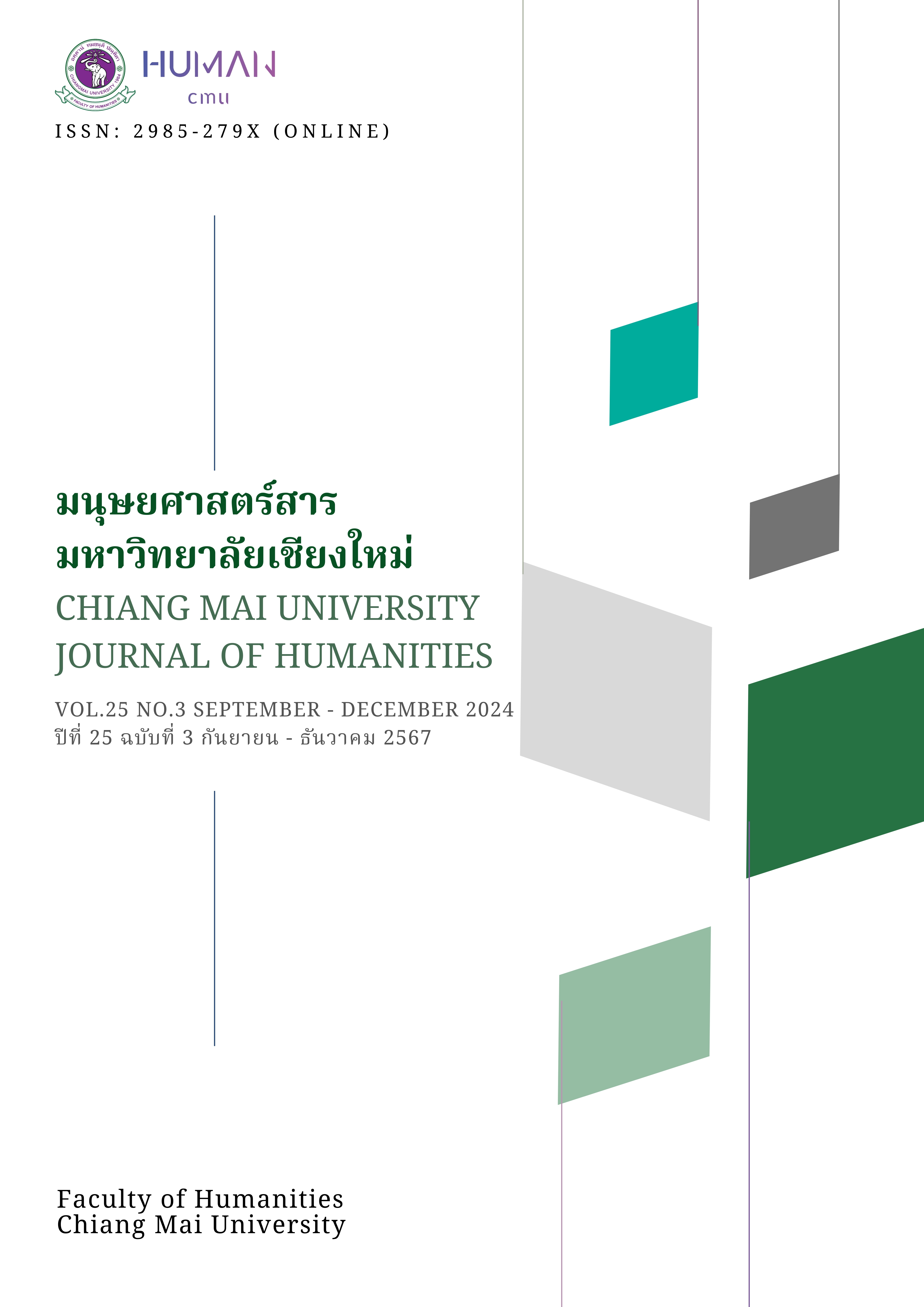Religious Worldview in Your Name (Kimi no na wa.): Exploring the Symbolism of “Musubi” (knotting) and “Sukui” (salvation)
Main Article Content
บทคัดย่อ
This study aims to elucidate the religious worldview in the globally acclaimed 2016 animated film Your Name. (君の名は。Kimi no na wa.). It focuses on the themes of “Musubi” (結び, knotting) and “Sukui” (救い, salvation) depicted in the work, analyzing them from the perspective of Japanese folklore and folk religion. While acknowledging the film's post-3.
11 (Great East Japan Earthquake) context, this research challenges critical views suggesting that the work implicitly reproduces assumptions of “men saving women” or “big cities saving rural areas.” The methodology adopts an interdisciplinary approach, treating the film as a cultural text and combining textual analysis with theories of Japanese folklore studies and narrative analysis. The study examines how “Musubi” (knotting) and “Sukui” (salvation) are established through narrative structures, character designs, and symbolic expressions, also considering connections to classical texts like the Kojiki (古事記, the oldest existing historical record) and the Manyoshu (万葉集, the oldest existing anthology of Japanese poetry).
The analysis reveals that the film skillfully establishes a complex network of “Musubi” (knotting) to achieve “Sukui” (salvation) through various elements including “Kotodama” (言霊, word spirit), mythological contexts, and rites of passage. Contrary to conventional interpretations, the findings indicate that “Musubi” (knotting) and “Sukui” (salvation) result from diverse forms of communication and connections based on overall harmony and cooperation grounded in a religious worldview. This research demonstrates how the film functions as a cultural text reflecting traditional knowledge of “Sukui” (salvation) for human crises in the modern context. It contributes to understanding how traditional Japanese concepts can respond to contemporary societal issues, opening new paths for exploring the dialogue between contemporary popular culture and traditional wisdom.
Article Details

อนุญาตภายใต้เงื่อนไข Creative Commons Attribution-NonCommercial-NoDerivatives 4.0 International License.
เอกสารอ้างอิง
DiNitto, R. (2018). The Fukushima fiction film: Gender and the discourse of nuclear containment. The Asia-Pacific Journal, 16(1), 1–13.
Gennep, A. V. (1960). The rites of passage. University of Chicago Press.
Ikeda, T. (1957). On the first poem of the Manyoshu [「万葉集開巻第一の歌」をめぐって]. The Seijo Bungei, 12, 22-36.
Iwasaki, T., Okata, Y., & Tsumura, M. (2018). Repeat Visitation Behavior of Anime Pilgrim Travelers : A Case of “Natsume Yujincho” in Hitoyoshi, Kumamoto [アニメ聖地巡礼におけるリピート行動分析 : 『夏目友人帳』熊本県人吉市における巡礼行動を事例として]. Contents Tourism Review, 5, 12-24.
Katayama, A. (2013). Research on the relationship between pilgrims and local communities at anime sacred sites: Using Johana, Nanto City, Toyama Prefecture as a case study [アニメ聖地における巡礼者と地域の関係性に関する研究富山県南砺市城端を事例として]. Tourism Studies Review, 1(2), 203-226.
Kawakatsu, M. (2013). The downfall of gods in “Spirited Away” A mirror image, the overturned scenery and "Reversible Destiny-Yoro Park" [『千と千尋の神隠し』における神々の零落 : 鏡像・風景の転倒・養老天命反転地をキーワードとして]. Bulletin of Saitama Gakuen University. Faculty of Humanities, 13, 181-192.
Komura, A. (2022). Anime and religion: Thinking about Japanese spirituality [アニメと宗教 : 日本人の宗教に対する姿勢を考える]. The Journal of Applied Sociology, 64, 137-146.
Masaki, A. (2002). Religious studies of ghosts and forests: Let's learn together with My Neighbor Totoro [お化けと森の宗教学 : となりのトトロといっしょに学ぼう]. Shunjusha.
Miyake, H. (1989). Religious folklore [宗教民俗学]. University of Tokyo Press.
Mori, H. (2019). Anime fans are “outsiders”: Can anime pilgrimage create new local leaders? [アニメファンは「よそ者」である : アニメ聖地巡礼は地域の担い手を生み出すか]. In H. Osone, S. Morita, M. Kanagawa, & H. Konishi (Eds.), Approach to welfare society (Junichi Kuzuka's rare celebration Vol. 2) [福祉社会へのアプローチ(久塚純一先生古稀記念論文集下巻)] (pp. 565-596). Seibundo.
Okamoto, T. (2010). Characteristics and research trends of anime pilgrimage to sacred places: Through a review of previous research and surveys [アニメ聖地巡礼の特徴と研究動向 : 既往研究および調査の整理を通して]. CATS Library, 4, 91-109.
_________. (2013). n-th creation tourism: Possibilities of anime pilgrimage/contents tourism/tourism sociology [n次創作観光 アニメ聖地巡礼 / コンテンツツーリズム / 観光社会学の可能性]. NPO Hokkaido Adventure Art Publishing.
Okata, Y., Iwasaki, T., & Tsumura, M. (Eds.). (2020). Behavioral characteristics and local measures of anime pilgrimage to sacred places - Considerations from case studies [アニメ聖地巡礼の行動特徴と地域施策 —事例からの考察—]. Kyushu University Press.
Osada, S., & Tomono, M. (2019). A study on local government's approach to content tourism: a case study of Hida City, Gifu [コンテンツツーリズムに対する自治体の取り組みについての一考察 : 岐阜県飛騨市の事例より]. The Hiyoshi Review of the Social Sciences, 30, 49-60.
Sadakane, H. (2016). What Your Name has erased behind the emotion: The other side of the film's touching story [『君の名は。』が、感動のウラで消し去ってしまったもの]. Gendai Business. https://gendai.media/articles/-/49807
Shinkai, M. (Director). (2016). Your Name. [Film; English subtitled version]. CoMix Wave Films; Production Committee.
_________. (2021). Consuming subculture: Historical sociology of manga and anime in 20th century Japan: 1920-2021 [サブカルチャーを消費する : 20世紀日本における漫画・アニメの歴史社会学 : 1920-2021]. Tamagawa University Press.
Swale, A. D. (2018). Shinkai Makoto: The "New Miyazaki" or a new voice in cinematic anime?. International Research Center for Japanese Studies, 263-271.
Tai, H. (2021). How do anime pilgrims interact with local community?: Web survey approach [アニメ聖地巡礼者は地域とどう関わるのか?: Web調査からのアプローチ]. Chihoujichi Fukuoka, 73, 30-47.
Teng, S. H. (2022). Time, disaster, new media: Your Name as a mind-game film. New Review of Film and Television Studies, 20(4), 459-488.
Thelen, T. (2019). Disaster and salvation in the Japanese periphery: “The Rural” in Shinkai Makoto's Kimi no na wa (Your Name). ffk Journal, 4, 215–230.
Thomas, J. B. (2012). Drawing on tradition: Manga, anime, and religion in contemporary Japan. University of Hawaii Press.
Turner, V. (1969). The ritual process: Structure and anti-structure. Aldine Publishing Company.
Yamamura, T. (2009). Tourism revolution and the 21st century: The modern meaning and potential of tourism as seen in the anime pilgrimage town development [観光革命と21世紀 : アニメ聖地巡礼型まちづくりに見るツーリズムの現代的意義と可能性]. CATS Library, 1, 3-28.


